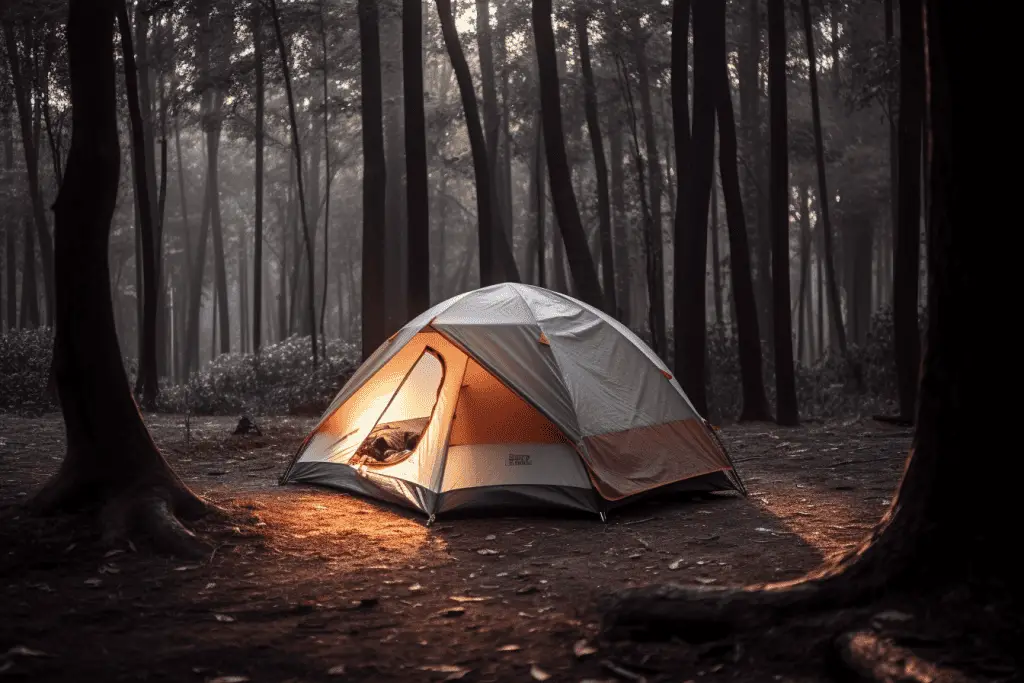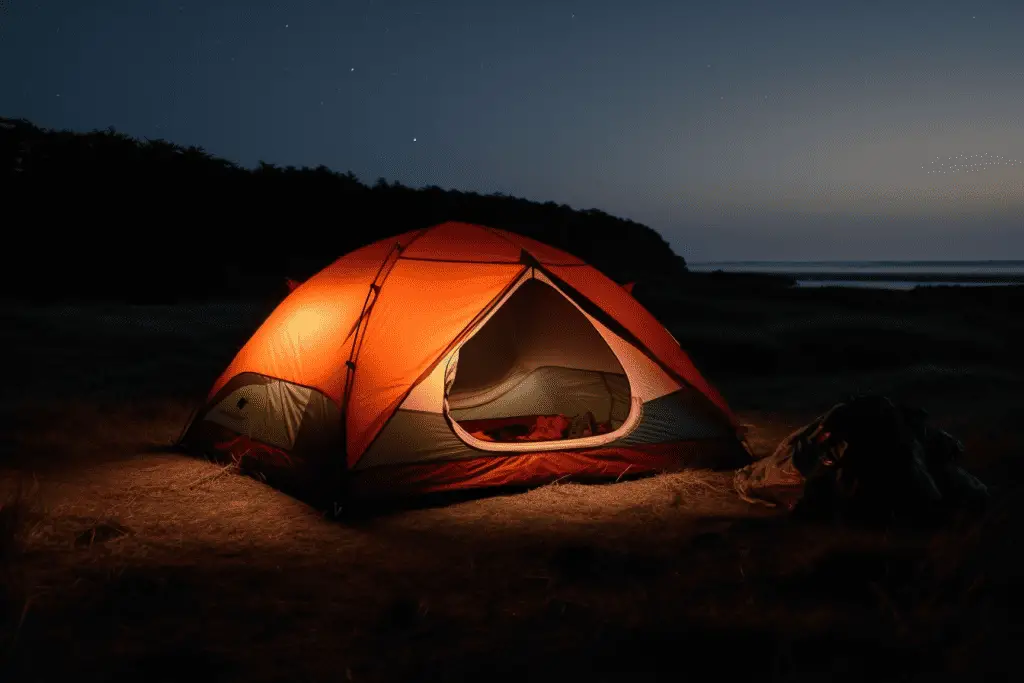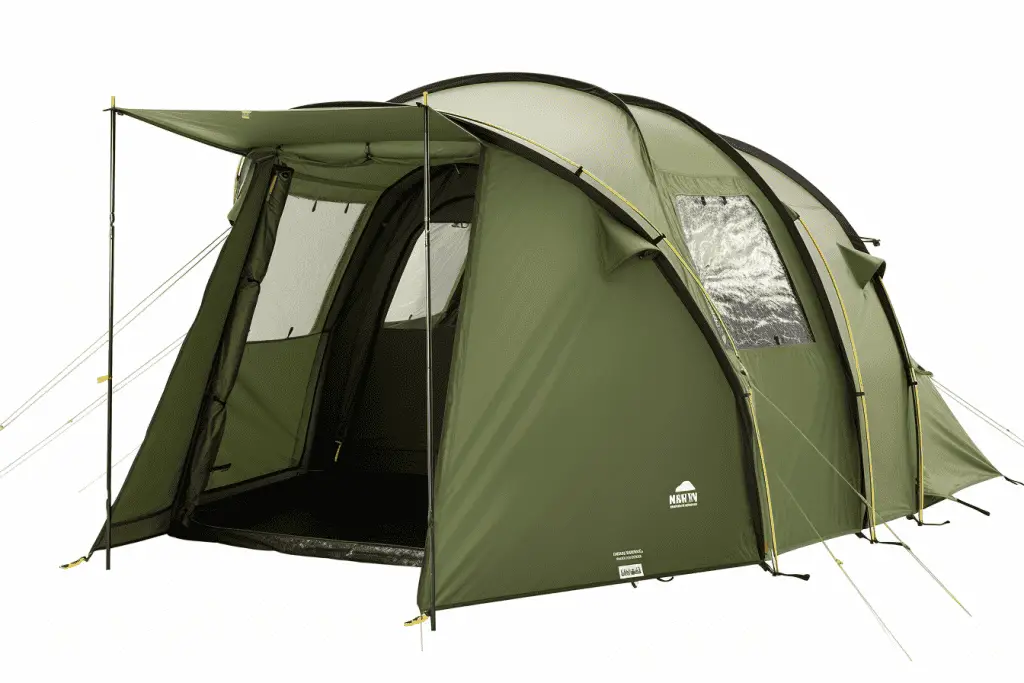You won’t find too many tents without some sort of tent vestibule these days. But what is a tent vestibule?
A tent vestibule is a covered area that is attached to the entrance of a tent. It provides extra storage space for gear and shoes, and can also serve as a sheltered area for cooking or relaxing. Vestibules are especially useful in wet or muddy conditions, as they help keep the interior of the tent clean and dry.

Types of Tent Vestibules
Think of a vestibule as the “mudroom” of your tent. It’s that nifty little space between the inside of your tent and the great outdoors. It’s the place where you stow your muddy boots, gear, or even your four-legged friend. But did you know that there are different types of tent vestibules?
Built-in Vestibules
The first type is the ‘built-in vestibule’. As the name suggests, it’s attached to the tent. These are ideal for most conditions as they create a nice, seamless seal against elements like rain and wind. This type is great for campers who prefer an all-in-one package and don’t want to bother with additional attachments.
Add-on Vestibules
Then, there’s the ‘add-on vestibule’, which is essentially an extension you can attach to your existing tent. These are perfect for campers who need a little more space, perhaps for storing extra gear or creating a covered cooking area. One of the best things about add-on vestibules is their versatility. You can choose to add it on or leave it behind based on your needs for each trip.
Garage Vestibules
And finally, there are ‘garage-style vestibules’. These are larger, and as the name implies, they provide the most storage space. In fact, they are roomy enough to park your bike in. They can turn a modest camping trip into a luxurious outdoor experience with ample room for cooking, lounging, and storage.
So, the next time you’re planning a camping trip, think about your vestibule needs. Each type has its unique perks, and the right one for you depends on your camping style and requirements.
Benefits of Tent Vestibules
Let’s talk about the real perks of having a tent vestibule on your camping trips. Here are 5 benefits of buying a tent with a tent vestibule.
- Extra Storage Space: A vestibule acts like a bonus room for your tent, ideal for stashing gear, boots, and other items to keep your sleeping area clutter-free.
- Weather Protection: It offers an extra layer of protection against the elements such as rain, wind, and even snow, acting like a covered porch where you can cook or relax.
- Privacy: It provides a private spot for changing clothes or performing other tasks without disturbing the whole tent.
- Pet-Friendly Space: For those who camp with pets, a vestibule can be a cozy, sheltered spot for your furry friends to sleep or relax.
- Organization: By providing a designated area for gear and other items, a vestibule can help keep your camping space tidy and organized.
So, next time you’re thinking about camping gear, don’t forget to consider a tent with a vestibule, it might just be the game-changer you need.
Can You Cook In A Tent Vestibule?
It is not recommended to cook in a tent vestibule as it can be a fire hazard and can also release harmful gases. It is best to cook outside of the tent in a designated cooking area.
If you decide to cook in it anyway, here are some tips to keep it as safe as possible.
- Never Cook in a Closed Vestibule: Always ensure there is adequate ventilation to avoid a build-up of harmful carbon monoxide.
- Fire Safety: Be aware that even a spark can catch your tent material on fire. It’s critical to always have a fire extinguisher or other method of quickly extinguishing fire close at hand.
- Use a Stable Camping Stove: Choose a camping stove with a solid, stable base to prevent it from tipping over.
- Keep the Flame Low: This can help reduce the risk of sparks or flames reaching your tent material.
- Never Leave the Stove Unattended: Always be vigilant when cooking in the vestibule, and never leave your stove unattended.
- Store Food Safely: Cooking in the vestibule might attract wildlife due to the smell of food, so it’s crucial to store food safely and away from the tent.
- Stay Alert, Stay Safe: Cooking in a vestibule involves risk management, so it’s essential to remain alert to any potential dangers.
Remember, safety should always come first when camping, so it’s important to follow these guidelines if you decide to cook in your tent’s vestibule.
How To Set Up a Tent Vestibule
Here is a quick guide for setting up your tent’s vestibule.
If your tent comes with a built-in vestibule:
- Pitch the Tent: Follow the instructions provided with your tent to set it up.
- Identify Vestibule Points: Recognize the parts of your tent that make up the vestibule. They will usually involve securing a few extra points to the ground.
- Secure the Vestibule: Use tent stakes to secure these extra points to the ground, pulling them tight to create tension.
- Check Your Work: Make sure all points are secure and the vestibule is taut. A loose vestibule can cause issues in windy conditions.
If you’re using an add-on vestibule:
- Pitch the Tent: Set up your tent as you normally would.
- Attach the Vestibule: Connect the add-on vestibule to the designated attachment points on your tent. These are often located around the door area.
- Secure the Vestibule: Use stakes to secure the vestibule to the ground, pulling the material taut.
- Check Your Work: Confirm all attachment points are secure and the vestibule is taut. This prevents it from flapping around in the wind.
Remember, every tent and vestibule setup might be slightly different. If in doubt, check with the manufacturer’s instructions or look up guides specific to your tent model.
Tent Vestibule Tips
First things first, when setting up your tent, always take into consideration where the vestibule will extend. You’ll want to position your tent so the vestibule isn’t extending into a high-traffic pathway, or a spot that’s prone to collecting rainwater. This helps to keep your ‘outdoor room’ a little more private and dry.
Secondly, when you’re dealing with rainy weather, remember to avoid touching the inner wall of the vestibule. It may be tempting to push out a sag or poke at a water droplet, but this can lead to water seeping through the fabric, which could get your gear wet or even dampen the interior of your tent.

And speaking of camping in the rain, don’t forget to dig a small trench around the perimeter of your vestibule if you’re expecting heavy rainfall. This little trick can help divert rainwater away from your gear and keep the interior of your vestibule dry.
Lastly, it’s crucial to remember to never store food in your vestibule overnight, especially when camping in areas with wildlife. The smell of food can attract animals, and you don’t want a curious bear or raccoon rummaging around your sleeping area!
With these tips in your camping toolkit, you’re sure to get the most out of your tent vestibule.
Alternatives to Tent Vestibules
While tent vestibules definitely offer a multitude of benefits, they may not be everyone’s cup of tea. For some, the additional weight, setup time, or cost may be a deterrent. So, what are the alternatives? Fear not, campers, there are other viable options like tarps and awnings that you can consider.
Use a Tarp
Tarps are a fantastic lightweight alternative. They’re extremely versatile and can be set up in a variety of ways to provide a sheltered outdoor space, similar to a vestibule. Tarps can cover a cooking area, create a dry spot for gear, or even provide an extra layer of protection over your tent. Plus, they pack down small and are typically lighter than a full tent with a vestibule, making them a favorite among backpackers.
Use an Awning
Awnings, on the other hand, are perfect for those who prioritize comfort and space. They attach to your tent, much like a vestibule, but are often larger and more open, giving you a broader view of your surroundings. Awnings are ideal for family camping trips or when camping with a group, where communal outdoor space is valued. They are great for providing shade during sunny weather or protection during a drizzle.

Keep in mind, though, while these alternatives do offer some benefits similar to a vestibule, they may not provide the same level of protection or convenience. For instance, an awning might not safeguard your gear as well as a vestibule in a heavy downpour. Similarly, a tarp may not offer the same level of privacy or integration with the tent as a built-in vestibule. But, if you’re willing to trade-off some aspects for others, such as weight for convenience, then these alternatives might be worth exploring.
Remember, camping is all about making the outdoors comfortable for you. So, whether it’s a vestibule, a tarp, or an awning, choose the one that suits your camping style and needs best!
Final Thoughts: Should You Buy a Tent With a Vestibule?
After diving into the world of tent vestibules, one thing is clear: a vestibule can greatly enhance your camping experience. From providing extra storage space to acting as a shield against the elements, it offers a slew of benefits that are hard to ignore. It’s especially useful for those who engage in extended camping trips or camp in variable weather conditions.
However, the decision to buy a tent with a vestibule should also take into account your personal camping style and needs. If you’re a minimalist backpacker aiming to keep your gear light, or you usually camp in mild weather, a tent without a vestibule could be just fine. But if you value having additional protected space for gear storage, changing clothes, or even cooking under cautious conditions, a tent with a vestibule is a worthy investment. In the end, it’s all about assessing your needs and making the choice that best fits your outdoor adventure style.
